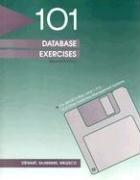I need the code to take an infix expression, convert it into postfix form, then evaluate it to find an answer to the expression using these generic Stack, generic Queue, generic List and generic node class
Generic Stack code:
public class Stack { /** List objects to hold our stack items. Use List operations to implement the methods below */ private List list;
public Stack() { // instantiate list here list = new List();
}
public void push(Gen value) { // appending the list list.append(value);
}
public Gen pop() { // throws exception if stack is empty if (isEmpty()) { throw new RuntimeException("Error! Stack is empty!"); } // gets last element from list Gen top = list.getValueAt(list.size() - 1); // deletes element list.deleteAt(list.size() - 1); // returns element return top; }
public Gen peek() { // throws exception if stack is empty if (isEmpty()) { throw new RuntimeException("Error! Stack is empty!"); } // gets last element Gen top = list.getValueAt(list.size() - 1); // return without deleting it return top; }
public boolean isEmpty() { // stack is empty if list is empty return list.size() == 0; } }
Generic Queue code:
public class Queue { /** List objects to hold our queue items. Use List operations to implement the methods below */ private List list; public Queue() { // instantiate list here list = new List(); } public void enqueue(Gen value) { // appends the value to the queue list.append(value); } public Gen dequeue() { // throws exception if stack is empty if (isEmpty()) { throw new RuntimeException("Error! Stack is empty!"); } // if not empty it gets the first element, deletes it, and then returns it Gen front = list.getValueAt(0); list.deleteAt(0); return front; }
public Gen front() { // throws exception if stack is empty if (isEmpty()) { throw new RuntimeException("Error! Stack is empty!"); } Gen front = list.getValueAt(0); return front; }
public boolean isEmpty() { // queue is empty if list is empty return list.size() == 0; } }
Generic singly linked list:
public class List { // put all fields from ListAsLinkedList class here private Node cur; private Node head; private Node tail; private int size = 0; // put all methods from ListAsLinkedList class here // Adds the characters to the end of the list public void append(Gen value) { if (head == null) { cur = new Node(); cur.setData(value); head = tail = cur; } else { cur = tail; Node temp = new Node(); cur.setNext(temp); cur = cur.getNext(); tail = cur; tail.setData(value); } size += 1; } // Adds the characters to the front of the list public void prepend(Gen value) { if (head == null) { cur = new Node(); cur.setData(value); System.out.println(cur); head = tail = cur; System.out.println(head); System.out.println(cur); } else { Node temp = new Node(); temp.setNext(head); head = cur = temp; head.setData(value); } size += 1; } // Deletes values at a certain position public void deleteAt(int position) { if (position >= 0 && position
/** A linked list node for our linked list */ class Node { // put all fields from Node class here private Gent data; private Node next; // put all methods from Node class here // Sets the node public Node() { data = null; next = null; } // Gets the value or character from the node public Gent getData() { return data; } // Gets the next node in the list public Node getNext() { return next; } // Sets the data public void setData(Gent data) { this.data = data; } // Sets what is linked next public void setNext(Node next) { this.next = next; } }
Create a file called Main.java that would contain a public class called Main. All work will be done inside this Main class. Here are the methods to be implemented inside this class:
Entry point: This should prompt the user for an infix expression, send that expression to the infixToPostfix method (described below), this will return a postfix expression (as a string), you will then send that to evalPostfix (described below) for evaluation, and then finally print out the summary shown in the sample output.
int getInfixPriority(char c): This takes in a char (a single character) and determines the infix priority as described in the notes. It then returns this priority.
int getStackPriority(char c): This takes in a char (a single character) and determines the stack priority as described in the notes. It then returns this priority.
boolean isOperand(char c): This will return true if c is an operand (basically a single digit from 0 to 9 inclusively). It will return false otherwise. To keep things simple, only single digit numbers are allowed in the input specified by the user. This means both the infix and the postfix notation will contain only single digit numbers. As you evaluate the expression, multi-digit numbers will naturally arise, and thats ok.
int eval(char operator, int a, int b): The operator character is one of the following operators: +, -, *, /, or ^. These are the only operators allowed (except for parentheses which is not handled by this method). Simply return a value of -1 if the operator is invalid. a and b are your operands. The order goes, a operator b. This method returns the result of applying the given operator, operator, to the operands, a and b
String infixToPostfix(String infixString): This method takes in an expression in infix form and produces the equivalent expression in postfix form. Here is where your stack and queue implementations will come into play. You must implement the algorithm from the notes. I dont want you grabbing some code from some online source and sticking it in here.
int evalPostfix(String postfixString): This takes an expression in postfix form and evaluates it, returning the evaluated result. All numbers are restricted to a single digit, no floating point numbers allowed, division symbols are handled as integer division, the final answer along with any intermediate answers are allowed to be multiple digits (i.e. it should return the mathematically correct answer, using integer division for any division).
String postfixToInfix(String postfixString): this method takes in an expression in postfix form and produces the equivalent expression in infix form.
Here are the notes:
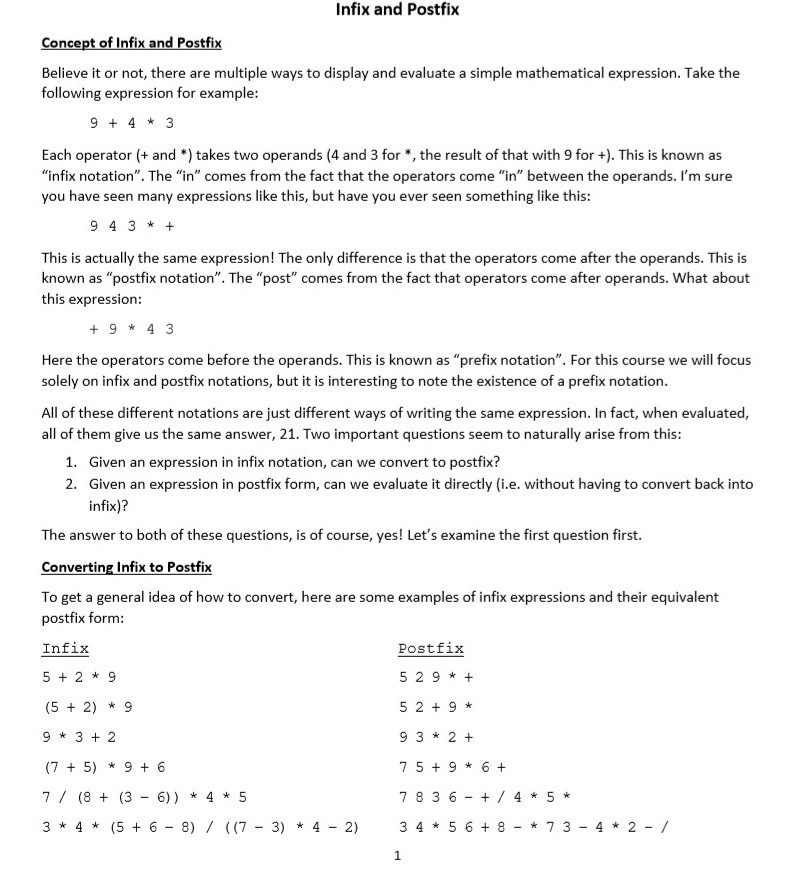
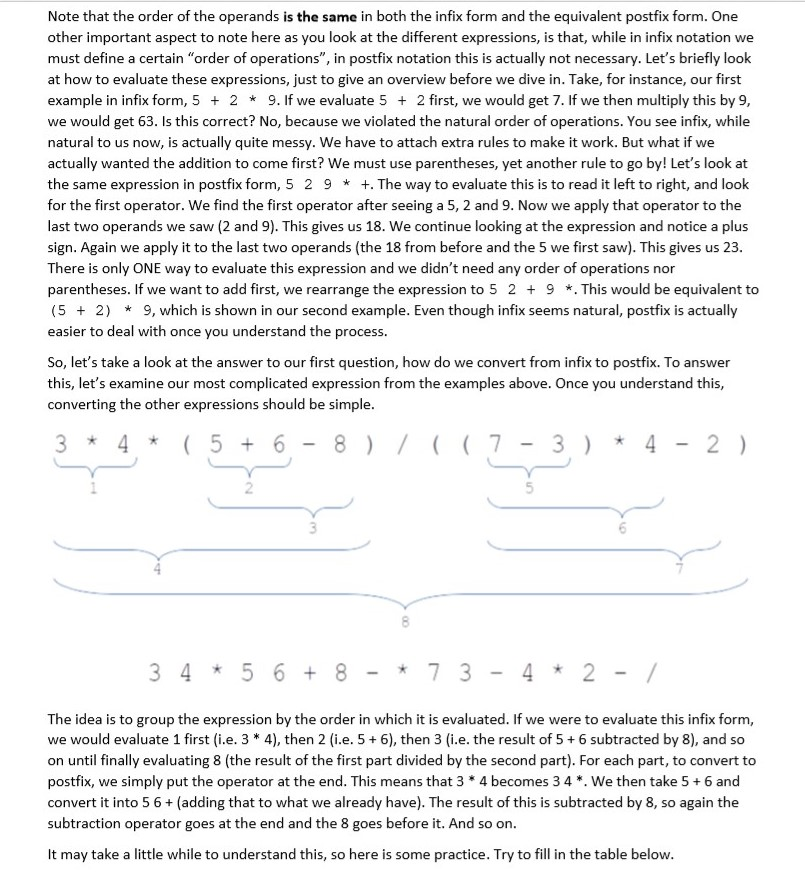
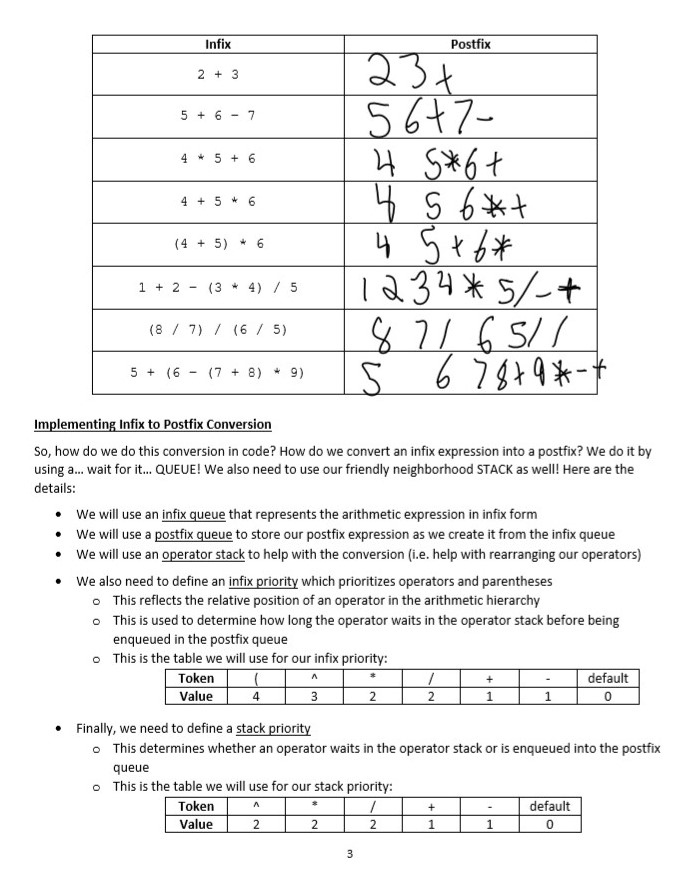
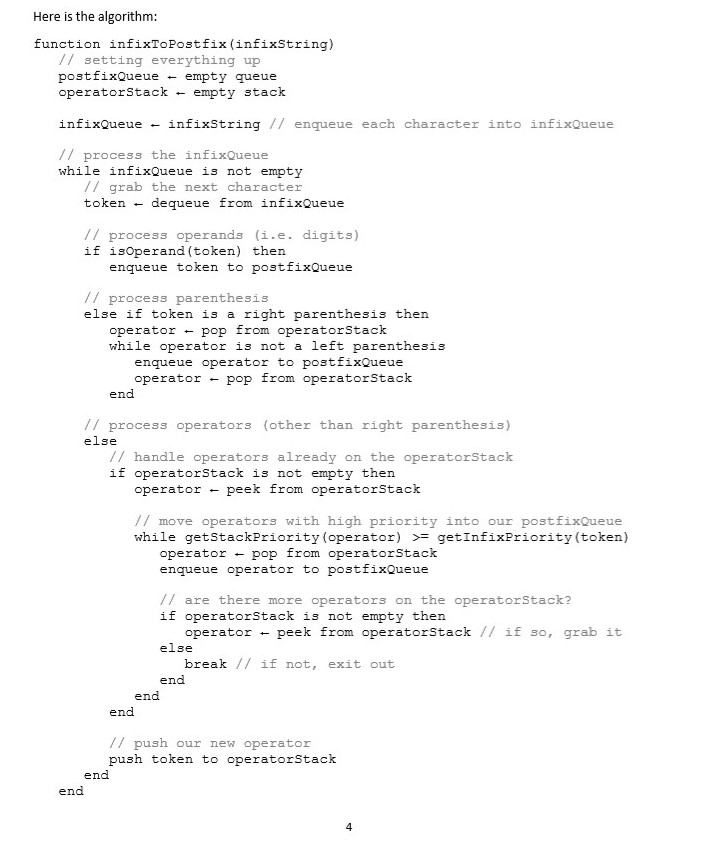
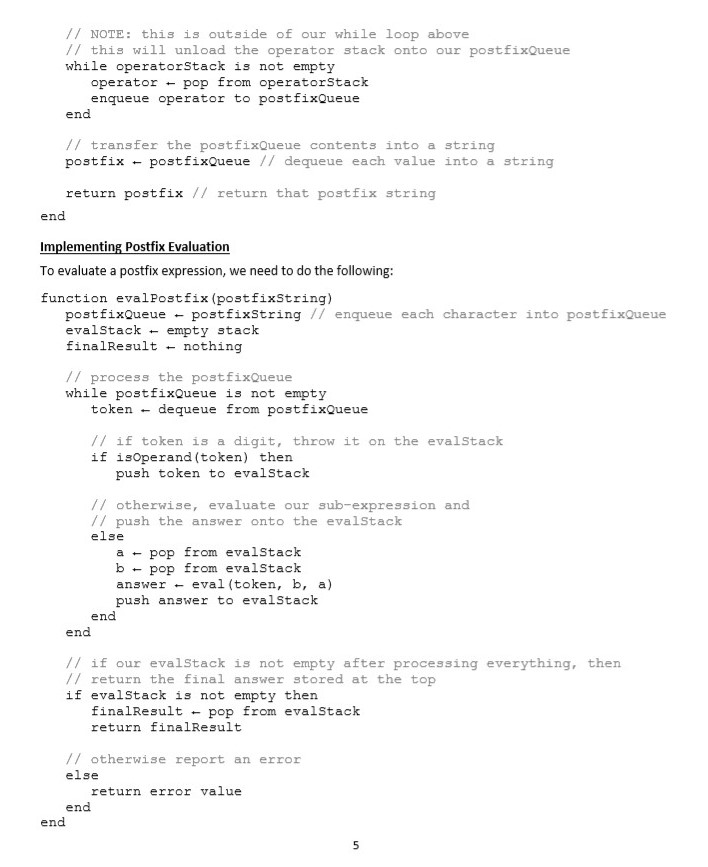
Infix and Postfix Concept of Infix and Postfix Believe it or not, there are multiple ways to display and evaluate a simple mathematical expression. Take the following expression for example: 9 + 4 * 3 Each operator (+ and *) takes two operands (4 and 3 for *, the result of that with 9 for +). This is known as "infix notation". The "in" comes from the fact that the operators come "in" between the operands. I'm sure you have seen many expressions like this, but have you ever seen something like this: 9 4 3* + This is actually the same expression! The only difference is that the operators come after the operands. This is known as "postfix notation". The "post" comes from the fact that operators come after operands. What about this expression: + 9 * 4 3 Here the operators come before the operands. This is known as "prefix notation". For this course we will focus solely on infix and postfix notations, but it is interesting to note the existence of a prefix notation. All of these different notations are just different ways of writing the same expression. In fact, when evaluated, all of them give us the same answer, 21. Two important questions seem to naturally arise from this: 1. Given an expression in infix notation, can we convert to postfix? 2. Given an expression in postfix form, can we evaluate it directly (i.e. without having to convert back into infix)? The answer to both of these questions, is of course, yes! Let's examine the first question first. Converting Infix to Postfix To get a general idea of how to convert, here are some examples of infix expressions and their equivalent postfix form: Postfix Infix 5 + 2 * 9 (5 + 2) * 9 9 * 3 + 2 (7 + 5) * 9 + 6 7 / (8 + (3 - 6)) * 4 * 5 3 * 4 * (5 + 6 - 8) / ((7 - 3) * 4 - 2) 5 2 9 * + 52 + 9* 93 * 2 + 75 + 9 * 6+ 7 8 3 6 - + / 4 * 5 * 3 4 * 5 6 + 8 - * 7 3 - 4 * 2 - / Note that the order of the operands is the same in both the infix form and the equivalent postfix form. One other important aspect to note here as you look at the different expressions, is that, while in infix notation we must define a certain "order of operations", in postfix notation this is actually not necessary. Let's briefly look at how to evaluate these expressions, just to give an overview before we dive in. Take, for instance, our first example in infix form, 5 + 2 * 9. If we evaluate 5 + 2 first, we would get 7. If we then multiply this by 9, we would get 63. Is this correct? No, because we violated the natural order of operations. You see infix, while natural to us now, is actually quite messy. We have to attach extra rules to make it work. But what if we actually wanted the addition to come first? We must use parentheses, yet another rule to go by! Let's look at the same expression in postfix form, 5 2 9 * +. The way to evaluate this is to read it left to right, and look for the first operator. We find the first operator after seeing a 5, 2 and 9. Now we apply that operator to the last two operands we saw (2 and 9). This gives us 18. We continue looking at the expression and notice a plus sign. Again we apply it to the last two operands (the 18 from before and the 5 we first saw). This gives us 23. There is only ONE way to evaluate this expression and we didn't need any order of operations nor parentheses. If we want to add first, we rearrange the expression to 5 2 + 9 *. This would be equivalent to (5 + 2) * 9, which is shown in our second example. Even though infix seems natural, postfix is actually easier to deal with once you understand the process. So, let's take a look at the answer to our first question, how do we convert from infix to postfix. To answer this, let's examine our most complicated expression from the examples above. Once you understand this, converting the other expressions should be simple. 3 * 4 * ( 5 + 6 - 8), 117 - 3) * 4 - 2) 34 * 5 6 + 8 - * 7 3 - 4 * 2-1 The idea is to group the expression by the order in which it is evaluated. If we were to evaluate this infix form, we would evaluate 1 first (i.e. 3 * 4), then 2 (i.e. 5 + 6), then 3 (i.e. the result of 5 + 6 subtracted by 8), and so on until finally evaluating 8 (the result of the first part divided by the second part). For each part, to convert to postfix, we simply put the operator at the end. This means that 3* 4 becomes 34*. We then take 5+6 and convert it into 5 6+ (adding that to what we already have). The result of this is subtracted by 8, so again the subtraction operator goes at the end and the 8 goes before it. And so on. It may take a little while to understand this, so here is some practice. Try to fill in the table below. Infix Postfix 2+ 3 2 + 3 5 + 6 - 7 4 * 5 + 6 4 + 4+5+6 5 * 6 723 5617- 1 4 6*6+ 4 5 6*t 4 5 +6* 1234* 5/-+ 8 2 6 5/1 s 6 7879 *-7 (4 + 5) + 6 1 + 2 - (3 * 4) / 5 1 +2 - 13 * 4) 75 18 / 7) / 16 / 5) 5 + 16 - 17 + 8) + 9) Implementing Infix to Postfix Conversion So, how do we do this conversion in code? How do we convert an infix expression into a postfix? We do it by using a... wait for it... QUEUE! We also need to use our friendly neighborhood STACK as well! Here are the details: We will use an infix queue that represents the arithmetic expression in infix form We will use a postfix queue to store our postfix expression as we create it from the infix queue We will use an operator stack to help with the conversion (i.e. help with rearranging our operators) We also need to define an infix priority which prioritizes operators and parentheses This reflects the relative position of an operator in the arithmetic hierarchy o This is used to determine how long the operator waits in the operator stack before being enqueued in the postfix queue o This is the table we will use for our infix priority: Token A + - default Value 4 3 2 2 1 1 0 Finally, we need to define a stack priority o This determines whether an operator waits in the operator stack or is enqueued into the postfix queue o This is the table we will use for our stack priority: Token T T . + L . default Value 2 2 2 1 1 0 Here is the algorithm: function infixToPostfix (infixString) // setting everything up postfixQueue - empty queue operatorStack - empty stack infixQueue - infixString // enqueue each character into infixQueue // process the infixQueue while infixQueue is not empty // grab the next character token - dequeue from infix Queue // process operands (i.e. digits) if isOperand (token) then enqueue token to postfixQueue // process parenthesis else if token is a right parenthesis then operator - pop from operatorStack while operator is not a left parenthesis enqueue operator to postfixQueue operator - pop from operatorStack end 17 process operators (other than right parenthesis) else // handle operators already on the operatorStack if operatorStack is not empty then operator - peek from operatorStack // move operators with high priority into our postfixQueue while getStackPriority (operator) >= getInfixPriority (token) operator - pop from operatorStack enqueue operator to postfix Queue // are there more operators on the operatorStack? if operatorStack is not empty then operator - peek from operatorStack // if so, grab it else break // if not, exit out end end end // push our new operator push token to operatorStack end end // NOTE: this is outside of our while loop above // this will unload the operator stack onto our postfixQueue while operatorStack is not empty operator - pop from operatorStack enqueue operator to postfix Queue end // transfer the postfixQueue contents into a string postfix - postfixQueue // dequeue each value into a string return postfix // return that postfix string end Implementing Postfix Evaluation To evaluate a postfix expression, we need to do the following: function evalPostfix (postfixString) postfixQueue - postfixString // enqueue each character into postfixQueue evalStack - empty stack finalResult - nothing // process the postfix Queue while postfix Queue is not empty token - dequeue from postfixQueue // if token is a digit, throw it on the evalStack if isOperand (token) then push token to evalstack // otherwise, evaluate our sub-expression and // push the answer onto the evalStack else a-pop from evalStack b-pop from evalStack answer - eval(token, b, a) push answer to evalStack end end // if our evalStack is not empty after processing everything, then // return the final answer stored at the top if evalStack is not empty then finalResult - pop from evalStack return finalResult // otherwise report an error else return error value end end Infix and Postfix Concept of Infix and Postfix Believe it or not, there are multiple ways to display and evaluate a simple mathematical expression. Take the following expression for example: 9 + 4 * 3 Each operator (+ and *) takes two operands (4 and 3 for *, the result of that with 9 for +). This is known as "infix notation". The "in" comes from the fact that the operators come "in" between the operands. I'm sure you have seen many expressions like this, but have you ever seen something like this: 9 4 3* + This is actually the same expression! The only difference is that the operators come after the operands. This is known as "postfix notation". The "post" comes from the fact that operators come after operands. What about this expression: + 9 * 4 3 Here the operators come before the operands. This is known as "prefix notation". For this course we will focus solely on infix and postfix notations, but it is interesting to note the existence of a prefix notation. All of these different notations are just different ways of writing the same expression. In fact, when evaluated, all of them give us the same answer, 21. Two important questions seem to naturally arise from this: 1. Given an expression in infix notation, can we convert to postfix? 2. Given an expression in postfix form, can we evaluate it directly (i.e. without having to convert back into infix)? The answer to both of these questions, is of course, yes! Let's examine the first question first. Converting Infix to Postfix To get a general idea of how to convert, here are some examples of infix expressions and their equivalent postfix form: Postfix Infix 5 + 2 * 9 (5 + 2) * 9 9 * 3 + 2 (7 + 5) * 9 + 6 7 / (8 + (3 - 6)) * 4 * 5 3 * 4 * (5 + 6 - 8) / ((7 - 3) * 4 - 2) 5 2 9 * + 52 + 9* 93 * 2 + 75 + 9 * 6+ 7 8 3 6 - + / 4 * 5 * 3 4 * 5 6 + 8 - * 7 3 - 4 * 2 - / Note that the order of the operands is the same in both the infix form and the equivalent postfix form. One other important aspect to note here as you look at the different expressions, is that, while in infix notation we must define a certain "order of operations", in postfix notation this is actually not necessary. Let's briefly look at how to evaluate these expressions, just to give an overview before we dive in. Take, for instance, our first example in infix form, 5 + 2 * 9. If we evaluate 5 + 2 first, we would get 7. If we then multiply this by 9, we would get 63. Is this correct? No, because we violated the natural order of operations. You see infix, while natural to us now, is actually quite messy. We have to attach extra rules to make it work. But what if we actually wanted the addition to come first? We must use parentheses, yet another rule to go by! Let's look at the same expression in postfix form, 5 2 9 * +. The way to evaluate this is to read it left to right, and look for the first operator. We find the first operator after seeing a 5, 2 and 9. Now we apply that operator to the last two operands we saw (2 and 9). This gives us 18. We continue looking at the expression and notice a plus sign. Again we apply it to the last two operands (the 18 from before and the 5 we first saw). This gives us 23. There is only ONE way to evaluate this expression and we didn't need any order of operations nor parentheses. If we want to add first, we rearrange the expression to 5 2 + 9 *. This would be equivalent to (5 + 2) * 9, which is shown in our second example. Even though infix seems natural, postfix is actually easier to deal with once you understand the process. So, let's take a look at the answer to our first question, how do we convert from infix to postfix. To answer this, let's examine our most complicated expression from the examples above. Once you understand this, converting the other expressions should be simple. 3 * 4 * ( 5 + 6 - 8), 117 - 3) * 4 - 2) 34 * 5 6 + 8 - * 7 3 - 4 * 2-1 The idea is to group the expression by the order in which it is evaluated. If we were to evaluate this infix form, we would evaluate 1 first (i.e. 3 * 4), then 2 (i.e. 5 + 6), then 3 (i.e. the result of 5 + 6 subtracted by 8), and so on until finally evaluating 8 (the result of the first part divided by the second part). For each part, to convert to postfix, we simply put the operator at the end. This means that 3* 4 becomes 34*. We then take 5+6 and convert it into 5 6+ (adding that to what we already have). The result of this is subtracted by 8, so again the subtraction operator goes at the end and the 8 goes before it. And so on. It may take a little while to understand this, so here is some practice. Try to fill in the table below. Infix Postfix 2+ 3 2 + 3 5 + 6 - 7 4 * 5 + 6 4 + 4+5+6 5 * 6 723 5617- 1 4 6*6+ 4 5 6*t 4 5 +6* 1234* 5/-+ 8 2 6 5/1 s 6 7879 *-7 (4 + 5) + 6 1 + 2 - (3 * 4) / 5 1 +2 - 13 * 4) 75 18 / 7) / 16 / 5) 5 + 16 - 17 + 8) + 9) Implementing Infix to Postfix Conversion So, how do we do this conversion in code? How do we convert an infix expression into a postfix? We do it by using a... wait for it... QUEUE! We also need to use our friendly neighborhood STACK as well! Here are the details: We will use an infix queue that represents the arithmetic expression in infix form We will use a postfix queue to store our postfix expression as we create it from the infix queue We will use an operator stack to help with the conversion (i.e. help with rearranging our operators) We also need to define an infix priority which prioritizes operators and parentheses This reflects the relative position of an operator in the arithmetic hierarchy o This is used to determine how long the operator waits in the operator stack before being enqueued in the postfix queue o This is the table we will use for our infix priority: Token A + - default Value 4 3 2 2 1 1 0 Finally, we need to define a stack priority o This determines whether an operator waits in the operator stack or is enqueued into the postfix queue o This is the table we will use for our stack priority: Token T T . + L . default Value 2 2 2 1 1 0 Here is the algorithm: function infixToPostfix (infixString) // setting everything up postfixQueue - empty queue operatorStack - empty stack infixQueue - infixString // enqueue each character into infixQueue // process the infixQueue while infixQueue is not empty // grab the next character token - dequeue from infix Queue // process operands (i.e. digits) if isOperand (token) then enqueue token to postfixQueue // process parenthesis else if token is a right parenthesis then operator - pop from operatorStack while operator is not a left parenthesis enqueue operator to postfixQueue operator - pop from operatorStack end 17 process operators (other than right parenthesis) else // handle operators already on the operatorStack if operatorStack is not empty then operator - peek from operatorStack // move operators with high priority into our postfixQueue while getStackPriority (operator) >= getInfixPriority (token) operator - pop from operatorStack enqueue operator to postfix Queue // are there more operators on the operatorStack? if operatorStack is not empty then operator - peek from operatorStack // if so, grab it else break // if not, exit out end end end // push our new operator push token to operatorStack end end // NOTE: this is outside of our while loop above // this will unload the operator stack onto our postfixQueue while operatorStack is not empty operator - pop from operatorStack enqueue operator to postfix Queue end // transfer the postfixQueue contents into a string postfix - postfixQueue // dequeue each value into a string return postfix // return that postfix string end Implementing Postfix Evaluation To evaluate a postfix expression, we need to do the following: function evalPostfix (postfixString) postfixQueue - postfixString // enqueue each character into postfixQueue evalStack - empty stack finalResult - nothing // process the postfix Queue while postfix Queue is not empty token - dequeue from postfixQueue // if token is a digit, throw it on the evalStack if isOperand (token) then push token to evalstack // otherwise, evaluate our sub-expression and // push the answer onto the evalStack else a-pop from evalStack b-pop from evalStack answer - eval(token, b, a) push answer to evalStack end end // if our evalStack is not empty after processing everything, then // return the final answer stored at the top if evalStack is not empty then finalResult - pop from evalStack return finalResult // otherwise report an error else return error value end end











